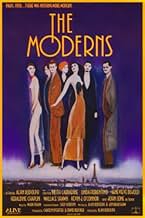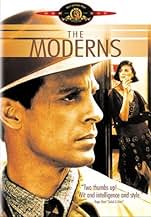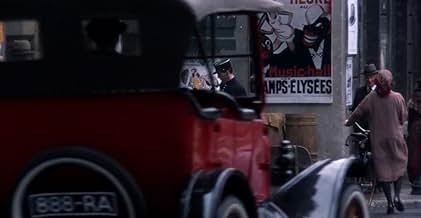IMDb-BEWERTUNG
6,6/10
2140
IHRE BEWERTUNG
Ein kämpfender Künstler wird angeheuert, um Gemälde zu schmieden, so dass er sich mit seiner Ex-Frau und ihrem mächtigen neuen Mann trifft.Ein kämpfender Künstler wird angeheuert, um Gemälde zu schmieden, so dass er sich mit seiner Ex-Frau und ihrem mächtigen neuen Mann trifft.Ein kämpfender Künstler wird angeheuert, um Gemälde zu schmieden, so dass er sich mit seiner Ex-Frau und ihrem mächtigen neuen Mann trifft.
- Regie
- Drehbuch
- Hauptbesetzung
- Auszeichnungen
- 2 Gewinne & 5 Nominierungen insgesamt
Geneviève Bujold
- Libby Valentin
- (as Genevieve Bujold)
Charlélie Couture
- L'Evidence
- (as Charlelie Couture)
Véronique Bellegarde
- Laurette
- (as Veronique Bellegarde)
Empfohlene Bewertungen
This may not be everyone's cup of tea, but it has a genuine, unpretentious charm to it that I found appealing.
Alan Rudolph made this delightful little ode to lies, trickery and delusion on a shoestring budget. The story of a failed painter down on his luck in Paris in the 1920's who accepts a comission to forge a famous impressionist painting. The film questions what is real versus what is perceived or subjective. In a series of criss-crossing subplots and seemingly random encounters Rudolph has fun playing with the trickery of film to made some sly points about the art forms we hold dear.
The film was shot in Montreal, Canada, standing in for Paris and New York in the 1920's, with French-Canadian actors playing Parisians... The plot twists include a millionaire art collector publicly slashing a priceless painting, thinking it a forgery, while the fake painting is sent to hang in a New York museum. A Dadaist poet fakes his own death in order to attend his funeral to hear the things people will say about him. Same character, named L'Oiseau is actually an American ex-patriate named Fagelman! In a toungue-in-cheek hommage to people's perception of the period, Rudolph has Papa Hemmingway hanging-out in all the cafe's and at all the parties... He is seemingly everywhere, sipping scotch and mouthing tough-guy cliches...
But the viewer must beware of what he is watching. In a scene where Bujold's character rides in a taxi with Carradine's we are treated to lovely rear projection shots through the cab's back window of impressionist paintings of Paris at night! In another dimly lit cafe scene Rudolph chose to end the scene by panning away from the action to the bar where among the extras in period costume, two punk rockers are watching a hockey game on t.v.
Alan Rudolph made this delightful little ode to lies, trickery and delusion on a shoestring budget. The story of a failed painter down on his luck in Paris in the 1920's who accepts a comission to forge a famous impressionist painting. The film questions what is real versus what is perceived or subjective. In a series of criss-crossing subplots and seemingly random encounters Rudolph has fun playing with the trickery of film to made some sly points about the art forms we hold dear.
The film was shot in Montreal, Canada, standing in for Paris and New York in the 1920's, with French-Canadian actors playing Parisians... The plot twists include a millionaire art collector publicly slashing a priceless painting, thinking it a forgery, while the fake painting is sent to hang in a New York museum. A Dadaist poet fakes his own death in order to attend his funeral to hear the things people will say about him. Same character, named L'Oiseau is actually an American ex-patriate named Fagelman! In a toungue-in-cheek hommage to people's perception of the period, Rudolph has Papa Hemmingway hanging-out in all the cafe's and at all the parties... He is seemingly everywhere, sipping scotch and mouthing tough-guy cliches...
But the viewer must beware of what he is watching. In a scene where Bujold's character rides in a taxi with Carradine's we are treated to lovely rear projection shots through the cab's back window of impressionist paintings of Paris at night! In another dimly lit cafe scene Rudolph chose to end the scene by panning away from the action to the bar where among the extras in period costume, two punk rockers are watching a hockey game on t.v.
A couple years ago I saw Trouble in Mind, and was immediately absorbed in the atmospheric world the film portrayed. I have since been dying to see another movie by the same director. Well, I've just seen the Moderns, and was immediately disappointed. While the film shares the same claustrophobic tendencies of the previous work, in this one it doesn't seem as deliberate, but more a matter of budgetary restraints. I never got the feeling that I was watching Paris, or 1920's Paris, for that matter. All I got was the sensation of watching stilted actors playing dress-up. The dialogue and plot for this movie is b-movie crust, which can be good, but the dreariness of the action and the way in which the film was filmed left it almost completely vacant of any charm. Cute references to pop culture from the 20's only sounds contrived and makes the film more apparent of what it isn't. One should get the feeling one is watching the 20's unfold without the crutch of references. We are never given any reason to care for any of the actors. They are cartoonish, but not cartoonish enough for them to be relieving and enjoyable. This movie takes itself far too seriously to be enjoyed as camp, which makes scenes involving fake suicide and real suicide all the more dour. The sets are perhaps more wooden than the characters, Hart's art atrocious. Hemmingway appears as a jocular Ethan Hawke ruffian, a pale shadow compared to Hart's masculinity. Lampooning famous people can be fine, but not when the only purpose of it is to rip them off and make them a clown with no real relevance to the story. I did, however, like the portrayal of Gertude Stein as a cliquish art snob. That's a more fair assessment. To be missed or slept through.
I must admit Alan Rudolph's work is hard to either greatly admire or sternly criticize. He has become one of these directors, like David Cronenberg or Paul Verhooven, that some love and some despise. But, the reality is it is hard to know where such directors stand. I must say that my feeling that Rudolph's films were too much like his mentor Robert Altman's has been changed upon seeing "The Moderns." While I am a huge fan of Altman, it has been hard for me too admire directors that seem too merely imitate him. But, this film is much more surreal than anything that Altman has done, especially in recent years. The film also establishes a clear mood and setting. Rudolph also selects very solid shots throughout the film. If there has been one disadvantage of the cinema medium over stage, it is that the audience can not see an actor's immediate response to a given situation because the focus is on another character. But, here Rudolph lets you inside virtually each of the characters. The cast is also solid. Keith Carradine is at his best. It is a shame that he now apparently has to go to Iceland to find cinematic roles, but if one thinks Jeff Bridges is an underrated actor there is proof- at least in this film--- that Carradine has been overlooked even more. I also think Wallace Shawn is great here, which is amazing considering that I am NOT a fan of the film "My Dinner with Andre." And, lastly Mark Isham's score is brilliant in this film. It may not be a film for all tastes, and because of its simplistic nature it is understandable why this film gets lost in the shuffle when it comes to discussions about great films from the 80s. Nevertheless, I think it is a remarkable film if not for anything else it does prove that an American can make a great movie set in Paris, which is not a musical, even if it was (as this film was) shot in Montreal!
Nick Hart (Keith Carradine) is an ex-patriot American painter who lives in Paris in the 1920's. He picks up some money selling caricatures but is very poor. An art gallery owner, Libby (Genevieve Bujold) is sympathetic but can't muster up many sales for Nick's work. Now, a wealthy divorcée. Nathalie (Geraldine Chapman) commissions Nick to make copies of some expensive paintings, as a sort of plot against her ex-husband. Reluctantly, Nick agrees. Complicating matters further is the fact that when Nick frequents his favorite bar, which is quite often, he runs into a beautiful, beautiful woman named Rachel (Linda Fiorentino) who happens to be married to a rich American businessman, Bertram (John Lone). Wouldn't you know, Bertie is a sadist and controls Rachel with an iron fist. He loves to do things like shave under Rachel's arms with a straight razer! So, two things are paramount to Nick. Will he begin to sell his art and will he be able to win Rachel away from her husband? This is quite a lovely film with a very great cast. Carradine does a fine job as the main character while Fiorentino is extremely lovely and touching. But, its Lone who practically steals the show, with his terrifying turn as the bad, bad guy. Most everyone will appreciate the gorgeous sets, costumes, art direction and photography. Then, too, the script is first rate while the direction is most competent. Look for the Moderns on your next video run.
Alan Rudolph does not make movies for everyone to see. His movies seem like personal projects that interest him at the time. Some of his movies I haven't been able to get involved in (Trixie, Mortal Thoughts, Afterglow) but with The Moderns, I was pulled in quickly. The story focuses on Keith Carradine's ex-patriot Nick Hart, a painter who has the ability to duplicate famous works of art with his brush. He's hired to create forgeries by Mademoiselle de Ville (Geraldine Chaplin).
But the story doesn't stop there. There are other ex-patriots around, including young Ernest Hemingway, comically portrayed by Kevin J. O'Connor; who is constantly drinking, philosophizing and pursuing women. It's not a flattering look at Hemingway, but somehow it adds to the whole ambience of the film and seems to ring true. And then there is Linda Fiorentino, a former lover of Nick's, and her husband, the rich and icy Bertram Stone (John Lone). The characters are odd and quirky, the story is uneven at times, and meanders a bit, but it is never boring. This movie has such style and depth that it pulls the viewer in, like we're trying to see the work that is under the painted canvas. That's what this movie is about -- the greater depth of art. What is art and what is crap? What is love and what is hate? What is real and what is illusion? As a director, Alan Rudolph pulls us along cleverly, with a hint of intrigue, the dichotomy of Nick's love and Hemingway's carousing, a taste of passion and the beauty of art. Then there are the characters who are well-layered works of art themselves. Maybe this movie isn't a masterpiece, but it leaves us chipping away at the paint trying to see what treasure is underneath. It's a movie to be enjoyed
But the story doesn't stop there. There are other ex-patriots around, including young Ernest Hemingway, comically portrayed by Kevin J. O'Connor; who is constantly drinking, philosophizing and pursuing women. It's not a flattering look at Hemingway, but somehow it adds to the whole ambience of the film and seems to ring true. And then there is Linda Fiorentino, a former lover of Nick's, and her husband, the rich and icy Bertram Stone (John Lone). The characters are odd and quirky, the story is uneven at times, and meanders a bit, but it is never boring. This movie has such style and depth that it pulls the viewer in, like we're trying to see the work that is under the painted canvas. That's what this movie is about -- the greater depth of art. What is art and what is crap? What is love and what is hate? What is real and what is illusion? As a director, Alan Rudolph pulls us along cleverly, with a hint of intrigue, the dichotomy of Nick's love and Hemingway's carousing, a taste of passion and the beauty of art. Then there are the characters who are well-layered works of art themselves. Maybe this movie isn't a masterpiece, but it leaves us chipping away at the paint trying to see what treasure is underneath. It's a movie to be enjoyed
Wusstest du schon
- WissenswertesIsabella Rossellini screen-tested to play Nathalie DeVille, but lost to Geraldine Chaplin.
Top-Auswahl
Melde dich zum Bewerten an und greife auf die Watchlist für personalisierte Empfehlungen zu.
- How long is The Moderns?Powered by Alexa
Details
Box Office
- Budget
- 3.500.000 $ (geschätzt)
- Bruttoertrag in den USA und Kanada
- 2.011.497 $
- Eröffnungswochenende in den USA und in Kanada
- 20.283 $
- 17. Apr. 1988
- Weltweiter Bruttoertrag
- 2.011.497 $
- Laufzeit2 Stunden 6 Minuten
- Farbe
- Sound-Mix
- Seitenverhältnis
- 1.85 : 1
Zu dieser Seite beitragen
Bearbeitung vorschlagen oder fehlenden Inhalt hinzufügen

Oberste Lücke
By what name was Wilde Jahre in Paris (1988) officially released in India in English?
Antwort
































